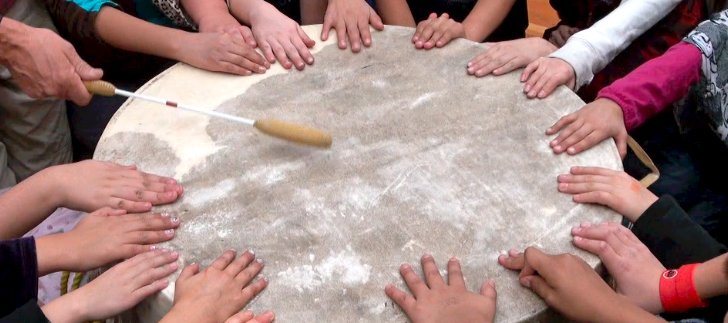About Us
Our People
Our Role
Our Annual Events
Programs
Our Grants
Funding Programs
SaskCulture Programs
Organizational Support

Bridging the Gap
By: Danica Lorer
November, 2014
In this issue
 Engage - Volume 5, Issue 1, Fall 2014
Engage - Volume 5, Issue 1, Fall 2014
Related Programs
Young participants recently had the opportunity to spend a week surviving without many of our modern conveniences. The youth spent time with elders, who taught them how to catch and clean fish, set traps, dry meat, prepare traditional food, make fish scale art and light a fire – even in the rain.
“You’ve got to have tradition with culture: you can’t have one or the other,” explains Ken Larson, an elder who participated this summer in a camp designed to pass on traditional Aboriginal teachings and ideas from elders down to youth. As a teacher, Larson values hands-on experiences when knowledge is passed on by participation. “It’s so easy for the kids to learn because they just follow you,” he adds.
Bridging the Gap - Elders and Youth Cultural Camp was held at Moose Bay, located on Churchill Lake, from July 14-20, 2014. Eighteen young people from ages 10 to 15 participated in the camp, which was coordinated by the Buffalo Narrows Friendship Centre, and made possible by support of SaskCulture’s Métis Cultural Development Fund.
At the camp, learning was balanced with fun. According to Larson, he prefers to teach both by example and by sharing his experiences. “Kids are famous for loving to swim and race. They do a lot of activities like boogie boarding and using tubes on the water with a boat,” he says. “Me? I never had a tube when I was a kid. Instead we used a piece of plywood, and we rigged it up with a short string – like for a horse – and we’d stand up on the plywood; however, we had to tie the string underneath the boat otherwise we would’ve took a nose dive to the bottom of the lake. We had to learn to balance.”
The interactive experience for the youth and elders was enhanced by the setting. “You can’t do it in town, it’s a whole different environment,” says Larson, who tries to teach young people how to face challenges without fear, to help them make good choices, and learn respect and responsibility while experiencing life in a more traditional manner.
Leah Chartier was one of the youth participants who would love to go back to the camp and pass on what she learned from the elders. “They talked a lot about their culture and how they lived when they were young – it was harder for them. They told us that when they were young they had to go outside to get water and haul in wood. They also had to fish with their own nets and pick wild rice. I loved listening to the stories,” she says.
Brenda Chartier, director, Buffalo Narrows Friendship Centre, explains their mandate is both traditional and cultural. “We have to teach these lessons to our youth, so to help them a live healthier lifestyle. To teach them their rightful heritage, instead of them not knowing who they are.” Located in the heart of the community, the centre is a busy hub where everyone is welcome. “We try to get our youth to interact more and more with our elders, and that’s something everybody is doing – not just Buffalo Narrows. It has a huge impact on our youth,” she says.

